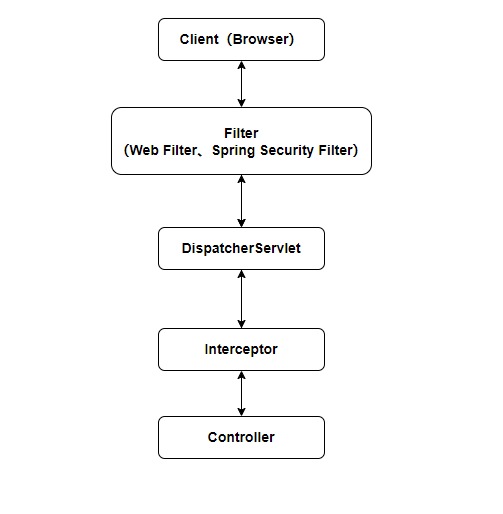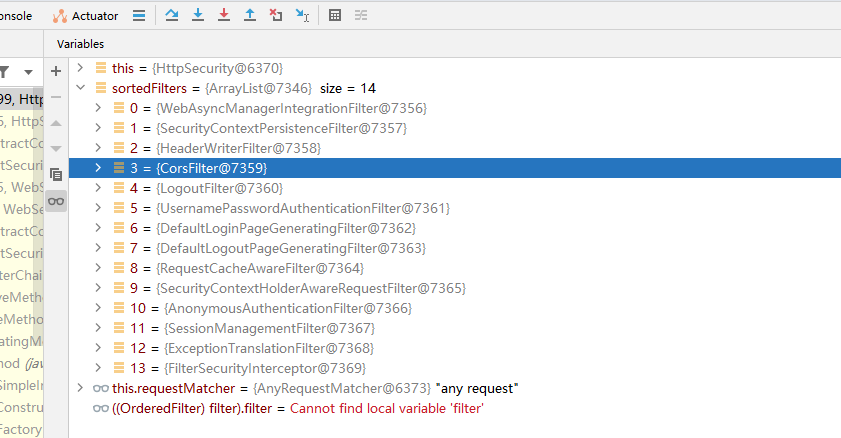什么是 CORS
CORS(Cross-Origin Resource Sharing)是由 W3C 制定的一种跨域资源共享技术标准,其目的就是为了解决前端的跨域请求。
在 JavaEE 开发中,最常见的前端跨域请求解决方案就是 JSONP,但是 JSONP 只支持 GET 请求,这是一个很大的缺陷,而 CORS 则支持多种 HTTP 请求方法,也是目前主流的跨域解决方案。
CORS 中新增了一组 HTTP 请求头字段,通过这些字段,服务器告诉浏览器,哪些网站通过浏览器有权限访问哪些资源,同时规定,对那些可能修改服务器数据的 HTTP 请求方法(如 GET 以外的 HTTP 请求等等),浏览器必须首先使用 OPTIONS 方法发起一个预检请求(preflight request),预检请求的目的是查看服务端是否支持即将发起的跨域请求,如果服务端允许,才能发起实际的 HTTP 请求。在预检请求的返回中,服务器端也可以通知客户端,是否需要携带身份凭证(如 Cookies、HTTP 认证信息等等)。
以 GET 请求为例,如果需要发起一个跨域请求,则请求头如下:
Host: localhost:8080
Origin: http://localhost:8081
Referer: http://localhost:8081/index.html
……如果服务端支持该跨域请求,那么返回的响应头中将包含如下字段:
Access-Control-Allow-Origin: http://localhost:8081Access-Control-Allow-Origin 字段用来告诉浏览器可以访问该资源的域,当浏览器收到这样的响应头信息后,提取出 Access-Control-Allow-Origin 字段中的值,发现该值包含当前页面所在的域,就知道这个跨域是允许的,因此就不再队前端的跨域请求进行限制。
这属于简单请求,即不需要进行预检请求的跨域。
对于一些非简单请求,会首先发送一个预检请求。预检请求类似下面这样:
OPTIONS /put HTTP/1.1
Host: localhost:8080
Connection: keep-alive
Accept: */*
Access-Control-Request-Method: PUT
Origin: http://localhost:8081
Referer: http://localhost:8081/index.html
……请求方法是 OPTIONS,请求头 Origin 字段告诉服务器当前页面所在的域,请求头 Access-Control-Request-Method 告诉服务端即将发起的跨域请求所使用的方法。服务端对比进行判断,如果允许即将发起的跨域请求,则会给出如下响应:
HTTP/1.1 200
Access-Control-Allow-Origin: http://localhost:8081
Access-Control-Allow-Meghotds: PUT
Access-Control-Max-Age: 3600
……Access-Control-Allow-Meghotds 字段表示允许的跨域方法;
Access-Control-Max-Age 字段表示预检请求的有效期,单位为秒,在有效期内如果发起该跨域请求,则不用再次发起预检请求。
预检请求结束后,接下来就会发起一个真正的跨域请求,跨域请求和前面的 GET 请求步骤类似。
这是关于 CORS 的一个简单介绍。
Web 原生过滤器处理方案
@WebFilter(filterName = "CorsFilter", urlPatterns = {"/*"})
public class CorsFilter implements Filter {
public void init(FilterConfig config) throws ServletException {
}
public void destroy() {
}
@Override
public void doFilter(ServletRequest request, ServletResponse response, FilterChain chain) throws ServletException, IOException {
HttpServletResponse httpServletResponse = (HttpServletResponse) response;
httpServletResponse.setHeader("Access-Control-Allow-Origin", "*");
httpServletResponse.setHeader("Access-Control-Allow-Methods", "*");
httpServletResponse.setHeader("Access-Control-Max-Age", "4200");
httpServletResponse.setHeader("Access-Control-Allow-Headers", "*");
httpServletResponse.setHeader("Access-Control-Allow-Credentials", "true");
chain.doFilter(request, response);
}
}Spring 处理方案
1、@CrossOrigin
Spring 中的第一种处理跨域的方式就是通过 @CrossOrigin 注解来标记支持跨域,该注解可以添加在方法上,也可以添加在 Controller 上。当添加在 Controller 上时,表示 Controller 中所有接口都支持跨域,具体配置如下:
@RestController
public class HelloController {
@GetMapping("/hello")
@CrossOrigin(origins = "http://localhost:8081")
public String hello() {
return "hello spring security!";
}
}@CrossOrigin 注解各个属性含义如下:
allowCredentials:浏览器是否应当发送凭证信息,如 Cookie;allowedHeaders:请求被允许的请求头字段,* 表示所有字段;exposedHeaders:哪些响应头可以作为响应的一部分暴露出来。注意,这里只可以一一列举,通配符 * 在这里无效;maxAge:预检请求的有效期,有效期内不必再次发送预检请求,默认是 1800 秒;methods:允许的请求方法,* 表示允许所有方法;origins:允许的域,* 表示允许所有域。
该注解的实现原理属于 Spring 范畴,现在只简单梳理一下 @CrossOrigin 注解执行过程:
(1)@CrossOrigin 注解在 AbstractHandlerMethodMappering 的内部类 MappingRegistry 的 register 方法中完成解析的。@CrosOrigin 注解中的内容会被解析成一个配置对象:CorsConfiguration;
(2)将 @CrossOrigin 所标记的请求方法对象 HandlerMethod 和 CorsConfiguration 一一对应存入一个名为 corsLookup 的 Map 集合中;
(3)当请求到达 DispatcherServlet#doDispatch 方法之后,调用 AbstractHandlerMapping#getHandler 方法获取执行链 HandlerExecutionChain 时,会从 corsLookup 集合中获取到 CorsConfiguration 对象;
(4)根据获取到 CorsConfiguration 对象构建一个 CrosInterceptor 拦截器;
(5)在 CrosInterceptor 拦截器中触发对 DefaultCorsProcessor#processRequest 的调用,跨域请求的校验工作将在该方法中完成。
2、addCorsMappings
@CrossOrigin 注解需要添加在不同的 Controller 上,所以还有一种全局的配置方法,就是通过重写 WebMvcConfigurerComposite#addCorsMappings 方法实现,具体配置如下:
官方文档:https://docs.spring.io/spring-boot/docs/current/reference/html/web.html#web.servlet.spring-mvc.cors
@Configuration
public class WebMvcConfig implements WebMvcConfigurer {
@Override
public void addCorsMappings(CorsRegistry registry) {
registry.addMapping("/**")
.allowedMethods("*")
.allowedOrigins("*")
.allowedHeaders("*")
.exposedHeaders("")
.maxAge(3600);
}
}addMapping 表示要处理的请求地址,接下来的方法含义和 @CrossOrigin 注解中属性的含义都一一对应。
这种配置方式最终的处理方式和 @CrossOrigin 注解相同,都是在 CorsInterceptor 拦截器中触发对 DefaultCorsProcessor#processRequest 的调用,最终在该方法中完成对跨域请求的校验工作,不过源码的执行略有差异:
(1)registry.addMapping("/**") 方法配置了一个 CorsRegistration 对象,该对象中包含了一个路径拦截规则,拦截规则的值就是 addMapping 方法的参数,同时 CorsRegistration 中还包含了一个 CorsConfiguration 配置对象,该对象用来保存这里跨域相关的配置;
(2)在 WebMvcConfigurationSupport#requestMappingHandlerMapping 方法中出发了 addCorsMappings 方法执行,将获取到的 CorsRegistration 对象重新组装为一个 UrlBasedCorsConfigurationSource 对象,该对象中定义了一个 corsConfigurations 变量(Map<String, CorsConfiguration>),该变量中保存了拦截规则和 CorsConfiguration 对象的映射关系;
(3)将新建的 UrlBasedCorsConfigurationSource 对象赋值给 AbstractHandlerMapping#corsConfigurationSource 属性;
(4)当请求到达时的处理方法和 @CrossOrigin 注解处理流程的第三步一样,都是在 AbstractHandlerMapping#getHandler 方法中处理,不同的是,这里是从 corsConfigurationSource 中获取 CorsConfiguration 对象,而 @CrossOrigin 注解则从 corsLookup 集合中获取到 CorsConfiguration 配置对象。如果两处都可以获取到 CorsConfiguration 对象,则对获取到的对象属性值进行合并;
(5)根据获取到的 CorsConfiguration 对象构建一个 CorsInterceptor 拦截器;
(6)在 CorsInterceptor 拦截器中触发对 DefaultCorsProcessor#processRequest 的调用,跨域请求的校验工作将在该方法中完成。
这两种跨域配置方式殊途同归,最终目的都是配置了一个 CorsConfiguration 对象,并根据该对象创建 CorsInterceptor 拦截器,然后在该拦截器中触发 DefaultCorsProcessor#processRequest 方法的执行,完成跨域的校验。另外需要注意的是,这里的跨域校验是由 DispatcherServlet 中的方法触发的,而 DispatcherServlet 的执行是在 Filter 之后,这一点需要牢记,后面会用到。
3、CorsFilter
CorsFilter 是 Spring Web 中提供的一个处理跨域的过滤器,开发者也可以通过该过滤器处理跨域:
@Configuration
public class WebMvcConfig {
@Bean
FilterRegistrationBean<CorsFilter> corsFilter() {
FilterRegistrationBean<CorsFilter> registrationBean = new FilterRegistrationBean<>();
CorsConfiguration corsConfiguration = new CorsConfiguration();
corsConfiguration.setAllowedHeaders(Arrays.asList("*"));
corsConfiguration.setAllowedMethods(Arrays.asList("*"));
corsConfiguration.setAllowedOrigins(Arrays.asList("*"));
corsConfiguration.setMaxAge(3600L);
UrlBasedCorsConfigurationSource source = new UrlBasedCorsConfigurationSource();
source.registerCorsConfiguration("/**", corsConfiguration);
registrationBean.setFilter(new CorsFilter(source));
registrationBean.setOrder(-1);
return registrationBean;
}
}CorsFilter 的配置也比较简单:
- 由于是在 Spring Boot 项目中,这里通过
FilterRegistrationBean来配置一个过滤器,这种配置方式既可以设置拦截规则,也可以为配置的过滤器设置优先级; - 在这里依然离不开
CorsConfiguration对象,不同的是我们手动创建该对象,并逐个设置跨域的各项处理规则; - 我们还需要创建一个
UrlBasedCorsConfigurationSource对象,将过滤器的拦截规则和CorsConfiguration对象之间的映射关系由UrlBasedCorsConfigurationSource中的corsConfigurations变量保存起来; - 最后创建一个
CorsFilter,并为其配置一个优先级。
在 CorsFilter 过滤器的 doFilterInternal 方法中,触发对 DefaultCorsProcessor#processRequest 的调用,进而完成跨域请求的校验。
和前面两种方式不同的是,CorsFilter 是在过滤器中处理跨域的,而前面两种方案则是在 DispatcherServlet 中触发跨域处理,从处理时间上来说,CorsFilter 对于跨域的处理时机要早于前面两种。
这就是 Spring 中为我们提供的三种不同的跨域解决方案,三种方式都能解决跨域问题,选择其中任意一种即可。需要说明的是:
@CrossOrigin注解 + 重写addCorsMappings方法同时配置,这两种方式中关于跨域的配置会自动合并,跨域在CorsInterceptor中只处理了一次;@CrossOrigin注解 +CorsFilter同时配置,或者重写addCorsMappings方法 +CorsFilter同时配置,都会导致跨域在CorsInterceptor和CorsFilter中各处理一次,降低程序允许效率,这种组合不可取。
Spring MVC 项目
上面是在 Spring Boot 中可以使用 FilterRegistrationBean 配置过滤器,如果是在 Spring MVC 项目中,直接这样做就可以了:
@Configuration
public class CorsConfig {
@Bean
public CorsFilter corsFilter() {
CorsConfiguration config = new CorsConfiguration();
config.addAllowedOrigin("*");
config.addAllowedMethod("*");
config.addAllowedHeader("*");
config.setMaxAge(3628800L);
UrlBasedCorsConfigurationSource source = new UrlBasedCorsConfigurationSource();
source.registerCorsConfiguration("/**", config);
return new CorsFilter(source);
}
}Spring Cloud Gateway
如果在 Spring Cloud 网关处配置跨域处理,则需要注入 CorsWebFilter,这是因为 Spring Cloud Gateway 是 WebFlux 的,并不采用 Servlet 体系。如果一定要在网关模块加入 web 支持,则需要引入 Spring Boot 对应的 webflux 启动器。
@Configuration
public class CorsConfig {
@Bean
public CorsWebFilter corsWebFilter() {
CorsConfiguration config = new CorsConfiguration();
config.addAllowedOrigin("*");
config.addAllowedMethod("*");
config.addAllowedHeader("*");
config.setMaxAge(3628800L);
UrlBasedCorsConfigurationSource source = new UrlBasedCorsConfigurationSource(new PathPatternParser());
source.registerCorsConfiguration("/**", config);
return new CorsWebFilter(source);
}
}Spring Security 处理方案
1、问题发现
当我们为项目中添加了 Spring Security 依赖后,发现上面三种跨域方式有的失效了,有的则可以继续使用,这是为什么呢?
- 通过
@CrossOrigin注解或者重写addCorsMappings方法配置跨域,统统失效了; - 通过
CorsFilter配置的跨域,有没有失效则要看过滤器的优先级:- 如果过滤器的优先级高于 Spring Security 过滤器,即先于 Spring Security 过滤器执行,则
CorsFilter所配置的跨域处理依然有效; - 如果过滤器优先级低于 Spring Security 过滤器,则
CorsFilter所配置的跨域处理失效。
- 如果过滤器的优先级高于 Spring Security 过滤器,即先于 Spring Security 过滤器执行,则
为了理清楚这个问题,我们先简略了解一下 Filter、DispatcherServlet 以及 Interceptor 的执行顺序,如下图:

上图描述了请求从浏览器到达 Controller 的过程,Filter、Servlet 以及 Interceptor 的执行顺序一目了然。
理清楚了执行顺序,再来看看跨域请求过程。
由于非简单请求都需要发送一个预检请求(preflight request),而预检请求并不会携带认证信息,所以预检请求就有被 Spring Security 拦截的可能。如果通过 @CrossOrigin 注解或者重写 addCorsMappings 方法配置跨域,最终都是在 CorsInterceptor 中对跨域请求进行校验的。要进入 CorsInterceptor 拦截器,首先要经过 Spring Security 过滤器链,而在经过 Spring Security 过滤器链时,由于预检请求没有携带认证信息,就会被拦截下来。
如果使用了 CorsFilter 配置跨域,只要过滤器的优先级高于 Spring Security 过滤器,即在 Spring Security 过滤器之前执行了跨域请求校验,那么就不会有问题。
如果 CorsFilter 的优先级低于 Spring Security 过滤器,则预检请求一样需要先经过 Spring Security 过滤器,由于没有携带认证信息,在经过 Spring Security 过滤器时就会被拦截下来。
2、处理方法
(1) 放行 OPTIONS 请求
在引入 Spring Security 后,如果还想继续通过 @CrossOrigin 注解或者重写 addCorsMappings 方法配置跨域,那么可以通过给 OPTIONS 请求单独放行,来解决预检请求被拦截的问题,具体配置如下:
@EnableWebSecurity
public class SecurityConfig extends WebSecurityConfigurerAdapter {
@Override
protected void configure(HttpSecurity http) throws Exception {
http.authorizeRequests()
.antMatchers(HttpMethod.OPTIONS).permitAll()
.anyRequest().authenticated()
.and()
.formLogin()
.and()
.csrf().disable();
}
}
在 configure(HttpSecurity http) 方法中直接指定所有的 OPTIONS 请求直接通过。
这种方案既不安全,也不优雅,所以并不推荐在实际开发中使用,仅作了解。
(2) 继续使用 CorsFilter
第二种方案则是使用 CorsFilter 来处理跨域,只需要将 CorsFilter 的优先级设置高于 Spring Security 过滤器优先级,配置如下:
@Bean
FilterRegistrationBean<CorsFilter> corsFilter() {
FilterRegistrationBean<CorsFilter> registrationBean = new FilterRegistrationBean<>();
CorsConfiguration corsConfiguration = new CorsConfiguration();
corsConfiguration.setAllowedHeaders(Arrays.asList("*"));
corsConfiguration.setAllowedMethods(Arrays.asList("*"));
corsConfiguration.setAllowedOrigins(Arrays.asList("http://localhost:8081"));
corsConfiguration.setMaxAge(3600L);
UrlBasedCorsConfigurationSource source = new UrlBasedCorsConfigurationSource();
source.registerCorsConfiguration("/**", corsConfiguration);
registrationBean.setFilter(new CorsFilter(source));
// 设置最高优先级
registrationBean.setOrder(Ordered.HIGHEST_PRECEDENCE);
return registrationBean;
}过滤器的优先级,数字越小,优先级越高,这里我们配置 CorsFilter 的优先级为最高。
当然这里也可以不设置最高优先级,我们只需要事先知道 Spring Security 的 FilterChainProxy 过滤器的优先级,然后将 CorsFilter 的优先级设置的比它高就可以了。
Spring Security 中关于 FilterChainProxy 优先级的配置在 SecurityFilterAutoConfiguration 类中,部分源码如下:
@Bean
@ConditionalOnBean(name = DEFAULT_FILTER_NAME)
public DelegatingFilterProxyRegistrationBean securityFilterChainRegistration(
SecurityProperties securityProperties) {
DelegatingFilterProxyRegistrationBean registration = new DelegatingFilterProxyRegistrationBean(
DEFAULT_FILTER_NAME);
registration.setOrder(securityProperties.getFilter().getOrder());
registration.setDispatcherTypes(getDispatcherTypes(securityProperties));
return registration;
}可以看到,过滤器的优先级是从 SecurityProperties 对象中读取的,该对象中默认的过滤器的优先级是 -100,即开发者配置的 CorsFilter 过滤器优先级只需要小于 -100 即可(开发者也可以在 application.properties 文件中,通过 spring.security.filter.order 配置去修改 FilterChainProxy 过滤器的默认优先级)。
3、专业解决方案
(1) 具体配置
Spring Security 中也提供了更加专业的方式去解决预检请求所面临的问题,具体配置如下:
@EnableWebSecurity
public class SecurityConfig extends WebSecurityConfigurerAdapter {
@Override
protected void configure(HttpSecurity http) throws Exception {
http.authorizeRequests()
.anyRequest().authenticated()
.and()
.formLogin()
.and()
.cors()
.configurationSource(this.corsConfigurationSource())
.and()
.csrf().disable();
}
CorsConfigurationSource corsConfigurationSource() {
CorsConfiguration corsConfiguration = new CorsConfiguration();
corsConfiguration.setAllowedHeaders(Arrays.asList("*"));
corsConfiguration.setAllowedMethods(Arrays.asList("*"));
corsConfiguration.setAllowedOrigins(Arrays.asList("*"));
corsConfiguration.setMaxAge(3600L);
UrlBasedCorsConfigurationSource source = new UrlBasedCorsConfigurationSource();
source.registerCorsConfiguration("/**", corsConfiguration);
return source;
}
}首先需要提供一个 CorsConfigurationSource 实例,将跨域的各项配置都填充进去,然后在 configure(HttpSecurity http) 方法中,通过 cors() 开启跨域配置,并将一开始配置好的 CorsConfigurationSource 实例设置进去。这样我们就完成了 Spring Security 中的跨域配置。
(2) 原理分析
cors() 方法开启了对 CorsConfigurer 的配置,对 CorsConfigurer 而言最重要的就是 configure 方法:
public class CorsConfigurer<H extends HttpSecurityBuilder<H>> extends AbstractHttpConfigurer<CorsConfigurer<H>, H> {
@Override
public void configure(H http) {
ApplicationContext context = http.getSharedObject(ApplicationContext.class);
CorsFilter corsFilter = getCorsFilter(context);
http.addFilter(corsFilter);
}
}可以看到,configure 方法就是获取了一个 CorsFilter 并添加到 Spring Security 过滤器链中。先看看 CorsFilter 是如何获取的:
private CorsFilter getCorsFilter(ApplicationContext context) {
if (this.configurationSource != null) {
return new CorsFilter(this.configurationSource);
}
boolean containsCorsFilter = context.containsBeanDefinition(CORS_FILTER_BEAN_NAME);
if (containsCorsFilter) {
return context.getBean(CORS_FILTER_BEAN_NAME, CorsFilter.class);
}
boolean containsCorsSource = context.containsBean(CORS_CONFIGURATION_SOURCE_BEAN_NAME);
if (containsCorsSource) {
CorsConfigurationSource configurationSource = context.getBean(CORS_CONFIGURATION_SOURCE_BEAN_NAME,
CorsConfigurationSource.class);
return new CorsFilter(configurationSource);
}
boolean mvcPresent = ClassUtils.isPresent(HANDLER_MAPPING_INTROSPECTOR, context.getClassLoader());
if (mvcPresent) {
return MvcCorsFilter.getMvcCorsFilter(context);
}
return null;
}可以看到这里一共有四种不同的方式获取 CorsFilter :
(1)如果 configurationSource 不为 null,则直接根据 configurationSource 创建一个 CorsFilter。我们前面的配置最终就是通过这种方式获取到 CorsFilter 实例的;
(2)Spring 容器中是否包含一个名为 corsFilter 的实例,如果包含,则从 Spring 容器中获取该实例并返回,这意味着我们也可以直接向 Spring 容器中注入一个 CorsFitler 实例;
(3)Spring 容器包含一个名为 corsConfigurationSource 的实例,如果包含,则根据该实例创建一个 CorsFilter 并返回。这意味着在前面的配置中,我们可以将自己创建的 CorsConfigurationSource 实例直接注入到 Spring 容器中(添加 @Bean 注解即可),然后在 configure(HttpSecuriry) 方法通过 cors() 方法开启跨域配置即可,不再用手动指定 CorsConfigurationSource 实例;
(4)HandlerMappingIntrospector 是 Spring Web 中提供的一个类,该类实现了 CorsConfigurationSource 接口,所以也可以根据这个创建一个 CorsFilter。
这是四种获取 CorsFilter 实例的方式。
拿到 CorsFilter 之后,调用 http.addFilter 方法将其添加到 Spring Security 过滤器链中,在过滤器链构建之前,会先对所有过滤器进行排序(之前在 HttpSecurity 中分析过),构建方法如下:
// org.springframework.security.config.annotation.web.builders.HttpSecurity
@Override
protected DefaultSecurityFilterChain performBuild() {
this.filters.sort(OrderComparator.INSTANCE);
List<Filter> sortedFilters = new ArrayList<>(this.filters.size());
for (Filter filter : this.filters) {
sortedFilters.add(((OrderedFilter) filter).filter);
}
return new DefaultSecurityFilterChain(this.requestMatcher, sortedFilters);
}debug 一下看看排序后的位置:

可以看到 CorsFilter 在 HeaderWriterFilter 之后,在认证过滤器之前,即进行跨域请求校验的时候还没有到认证那一步。
(3) 总结
至此,Spring Security 中关于跨域问题的处理就清晰了,Spring Security 根据开发者提供的 CorsConfigurationSource 对象构建出一个 CorsFilter,并将该过滤器置于认证过滤器之前。
Spring Security 中关于跨域的三种处理方案,推荐最后一种。



